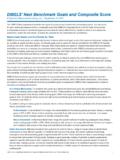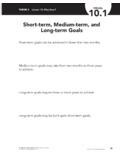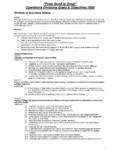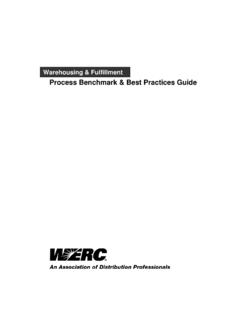Transcription of Setting Quality Goals - Schneiderman
1 Quality Progress April 1988 51 Setting Quality GoalsUse observed rates of continuousimprovement to position targets. EW SUBJECTS IN THE ARENA OF Quality and productivity evoke such extreme reactions as goal Setting . Advice on this subject varies widely and is rarely specific or proven. Experiences of both people who set Goals and people who must meet them are almost universally frustrating, to say the least. And yet most people seem to have a basic need to set specific Goals and to achieve them. For example, few Americans who were part of it have forgotten this country's goal of placing a man on the moon and returning him safely to earth by 1970. And who did not thrill in its achievement? Unfortunately, most Goals lack that specificity; they fail to define both a rational objective and a time line for its achievement.
2 What is needed is an empirically based goal- Setting model for legitimate Quality improvement process (QIP) activities. by Arthur M. Schneiderman 1988 American Society for Quality Control The leaders and goal Setting Consider the theories of goal Setting of three leaders of the QIP movement: W. Edwards Deming, Philip B. Crosby, and Joseph M. Juran. Deming addresses Goals in the tenth of his 14 Points: Eliminate numerical Goals for the work force (and for management) .. Goals are necessary for you and me, but numerical Goals set for other people, without provision for a road map to reach the goal, have effects opposite to the effects sought. They generate frustration and resentment. The message that they carry to everyone is that management is dumping their responsibilities onto the work force.
3 Why advertise the helplessness of management? .. The company will of course have a goal, namely, never-ending improvement. 1 Crosby, coincidentally, also deals with Goals in the tenth of his 14 Steps: Action: During meetings with employee, each supervisor requests that they establish the Goals they would like to strive for. Usually, there should be 30-, 60-, and 90- day Goals . All should be specific and capable of being measured. Accomplishment: This phase helps people learn to think in terms of meeting Goals and accomplishing specific tasks as a team. 2 Comment: Don t let people settle for easy tasks. Post the Goals in a conspicuous place. 3 Juran's systematic approach to company-wide Quality management (CWQM) 4 states: =Establish policies and Goals for Quality . =Establish plans for meeting these Quality Goals .
4 =Provide the resources needed to carry out the plans. =Establish controls to evaluate progress against Goals and to take appropriate action. =Provide motivation to stimulate the personnel to meet the Quality Goals . F Quality Progress April 1988 52 Table 1. Observed QIP Half-Lives The measurement of improvement half-life can be done with almost any regression or curve-fitting package using the exponential model. A usually adequate alternative is the following graphical method: =On semi-logarithmic graph paper, plot the defect level (y-axis, log scale) against time (x-axis, linear scale). =Draw by eyeball the best fit straight line through the data. =Draw a line parallel to this that intersects the y-axis at an even number, say 10%. =At a point on the y-axis that is half of the y-intercept value of the best straight line ( , 5%), draw a horizontal line. =Drop a vertical line from the intersection of the horizontal line and the parallel line you drew earlier.
5 =The time interval between the x-axis origin and your last line's intersection with the x-axis approximates the actual half-life. (This approximation can be improved by dropping by more than one halving of the defect level and dividing by the number of halvings used.) Half-life Improvement Description (months) Cycles R2 Operations sheet errors Days late in delivery Rejects caused by bends and dents Process sheet errors PCB photo imaging resist flake Errors in purchase orders Aluminum smears from IC test pads Yield loss, die coat inspection Scrap costs, die coat inspection Defective stockings Yield loss, PCB photo imaging Typing errors in bank telegram department Late orders to customers Defects in PCB edge polishing Insertion defect rate Failure rate, dip soldering process Downtime of facilities COPQ, goggles manufacturer Scrap and repair costs Scrap and repair costs In-process defect rate Late spare parts to customers Defects caused by pits, piston rings Defects in vacuum molding Vendor defect level.
6 Capacitors Customer returns caused by administrative error WIP Accounting miscodes Manufacturing scrap Vendor defect level, transformers Vendor defect level, IC linears WIP Failure rate, line assembly Manufacturing cycle time Defects per unit Rework rate Off-spec rejects Setup time Vendor defect level, transistors Defect levels, customers' incoming QC Defects Software documentation errors Error rate, perpetual inventory Customer returns because of product Missing product features Equipment downtime Scrap costs Absenteeism caused by accidents Defects at turn on Manufacturing cycle time Defects on arrival Nonconformances Vendor defect level, microprocessors Quality Progress April 1988 53 Figure 1.
7 Forms of Waste (Muda) Ryuzaburo Kaku, Canon The Nine Wastes Taiichi Ohno, Toyota The Seven Wastes Waste in rejects Waste in parts inventory Waste in indirect labor Waste in equipment and facilities Waste in expenses Waste in design Waste in human resources Waste in operations Waste in production start-us of new products Waste in processing itself Waste of time Waste of making defective parts Waste of motion Waste of overproduction Waste of inventory Waste of transportation Juran goes on to note: The fact that a goal is set does not prove that it will be met; to meet it may require a significant improvement over past performance. The process for establishing Quality Goals includes a degree of voluntarism and negotiation. Quality Goals are neither uniform nor static. They vary from one organization to another, and from one year to the next.
8 5,6 Although Crosby seems to be an absolute proponent of goal Setting , Juran (explicitly) and Deming (implicitly) advocate goal Setting only in the presence of a clear means of achieving that goal. However, the tone of their admonitions suggests that such means may lie wholly in the eye of the improver. Therein lies the basic flaw in current goal Setting : specific Goals should be set based on knowledge of the means that will be used to achieve them Yet the means are rarely known at the time Goals are set. The usual result is that if the goal is too low, we will underachieve relative to our potential. If the goal is too high, we will underperform relative to others' expectations. What's really needed to set rational Goals is a means of predicting what is achievable if some sort of standard means for improvement were used.
9 I propose that This standard or universal means is the Quality improvement process (QIP). A legitimate QIP is a process that achieves a benchmark rate of continuous improvement. Like ocher benchmarks, this one also changes with time. Perhaps an analogy might be useful at this point. One of the primary determinants of how fast an automobile can get from point A to point B is its engine. Technological power has led to an ever-increasing power-to-weight ratio for engines. However, at any point in time, the state of the art is well-known to most automobile aficionados. For people who are on the Quality journey, the state-of-the-art improvement engine today is QIP (or TQC, CWQC, EI, or whatever else it is called). What is needed now is a model that will provide a means of measuring the effective power-to-weight ratio of the engine that is driving a given improvement project.
10 The model Faced with an ever-increasing number of requests, from both senior managers and QIP team participants, for guidance in Setting Goals , I had been searching for a means of rational goal Setting . In an attempt to combine two graphs into one, I inadvertently made a transformation of some data provided by Yokogawa Hewlett Packard7 that suggested a simple model for the results of QIP activity. The hypothesis that forms the basis of this model is the following: any defect level, subjected to legitimate QIP, decreases at a constant rate, so that when plotted on semi-log paper against time, it falls on a straight line. So what? Well, a straight line has two interesting characteristics. Most important, it is easy to extrapolate. But also, it is easy to characterize. The model takes on the mathematical form: ()()YYY Yat tt = minminexp0012 where Ymin equals the defect level, Ymin equals the minimum achievable defect level, Y0 equals the initial defect level, t equals time, t0 equals initial time, a equals ln(2), and t equals defect half-life.






